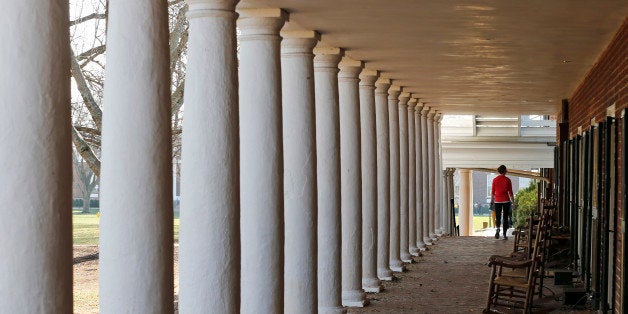
The issue of campus sexual assault has received a great deal of attention in the media in recent months. This is warranted. There is a real problem on college and university campuses, and it is a problem that must be taken seriously. Rape and other forms of sexual violence and sexual assault are intolerable whenever and wherever they occur.
Some people say that, because such actions are crimes, colleges and universities should not attempt to adjudicate the issues, but should simply turn these cases over to the criminal justice system. I do not agree. Colleges and universities have an independent responsibility to keep their students safe and to ensure that they can live and learn in an environment free from sexual violence.
But the concern with campus sexual assault has begun to take on the characteristics of a panic in which government officials and school administrators have increasingly lost sight of other fundamental values that must shape the culture of institutions of higher learning.
In this post, I will address two issues that have caused me particular concern and about which I want to sound a bit of an alarm. The first concerns issues of substance, the second concerns issues of process.
The federal Department of Education has put serious pressure on colleges and universities to take aggressive action to deal more effectively with the issue of campus sexual assault. In principle, this is a sound and important step in the right direction. But the Department of Education has declined to define precisely what it means by sexual assault. Clearly, it includes the crime of rape. But the meaning of sexual assault, at least as used in this context, can be extremely, and dangerously vague.
Fundamentally, it is bound up with such concepts as "consent" and "unwanted" sex. The problem is in defining how those concepts apply in this context. In many instances, especially where alcohol is involved, as it often is, extremely difficult questions arise about the meaning of "consent" and "unwanted." Is it measured by the subjective state of mind of the "complainant" or by the reasonable understanding of the "accused"? How are the participants, and the institutions, to know whether in any given interaction the accused crossed the line?
At the moment, academic institutions are at sea on this question. Some institutions now declare that in any sexual encounter there is a presumption of lack of consent, and thus coercion, unless the complainant affirmatively expressed consent at every step in the interaction. Others hold that sexual assault exists only if the accused disregarded a clearly expressed lack of consent. These definitions, and the many other variations that different institutions now employ, are inconsistent with one another, difficult to apply in practice, and confused still further when both individuals were under the influence of alcohol at the time of the incident.
The Department of Education has not clarified what it thinks the appropriate standard should be. It has sent strong signals, however, that colleges and universities must be tough on those who commit "sexual assault," however defined. The result is that academic institutions feel compelled to adopt very broad definitions of sexual assault for fear that if they get it "wrong" the Department will find them in violation of federal law and strip them of federal funds -- a penalty that strikes at the very heart of many colleges and universities.
To eliminate such overreaction on the part of academic institutions, the Department should set a clear -- and sensible -- standard for what counts as sexual assault. This standard should focus on the reasonable understanding of the accused rather than on the subjective understanding of the complainant. To impose serious discipline on students for committing sexual assault when they could not reasonably have understood in the circumstances that the sexual interaction was unwanted sets a standard of culpability that is both unfair to the accused and demeaning to the complainant.
The latter point is worth some elaboration. In these situations, the complainant is almost always (though not always) a woman. In the absence of either a reasonable fear of danger or serious incapacitation from drugs or alcohol, the woman in this situation who does not want the sexual encounter should reasonably be expected to make her feelings known at the time. Women students need to be protected from coercion, but they should not be treated as if they are inherently incapable of expressing their feelings, their wants, and their desires.
Women students fought long and hard to be treated by colleges and universities as individuals capable of making responsible decisions for themselves. The days of parietal hours are happily behind us. For the federal government -- or for colleges and universities -- to suggest that women students are incapable of making appropriate decisions or of expressing their minds clearly denies them equal dignity and reinforces all the wrong messages about the integrity, independence, and maturity of women. Colleges and universities should not treat their women students as if they are frail, helpless, and weak.
The second issue concerns process. Assume that a female student accuses a male student of sexual assault. She alleges that they had some drinks at a party, they went to his room, they made out naked for a while, he took a condom out of his wallet, she said "no," and he nonetheless entered her. He says that she never said "no" or that, if she did, he didn't hear it, and that she acted as if she desired sex. He says that he thought it was consensual.
If the male student is found to have engaged in sexual assault, he may be suspended or expelled. If female student in fact said "no" and he clearly disregarded her lack of consent, expulsion would surely be appropriate. The critical question, though, is what actually happened at that moment, and in sorting that out the burden of proof is central. By what standard should the fact finder have to decide whether her story or his story is true, before expelling him?
According the Department of Education, in all such proceedings "the evidentiary standard that must be used" is "preponderance of the evidence," that is, whether it is "more likely than not" that he committed a sexual assault. In my judgment, that is the wrong standard. Indeed, many if not most colleges and universities have traditionally applied the "clear and convincing evidence" standard in such circumstances. The difference between these two standards is roughly the difference between being 51 percent confident that the student committed the sexual assault before expelling him and being 75 percent confident that the student committed the sexual assault before expelling him.
To justify its insistence on the preponderance of the evidence standard, the Department of Education draws an analogy to civil actions in court. In the typical civil law suit for damages, whether the issue is a car accident, a breach of contract, or an assault, the standard is preponderance of the evidence. But this is a bad analogy.
For a college or university to expel a student for sexual assault is a matter of grave consequence both for the institution and for the student. Such an expulsion will haunt the students for the rest of his days, especially in the world of the Internet. Indeed, it may well destroy his chosen career prospects. This is especially likely, for example, for law students.
Moreover, the procedures used in these disciplinary hearings do not come close to those employed in civil actions, which involve judges, juries, rules of evidence, lawyers, discovery, and a host of other procedural protections designed to enhance the reliability of the proceedings. Even at their best, college and university disciplinary proceedings are a far cry from civil actions in terms of fairness to the accused.
Thus, although the Department of Education may well be right that "proof beyond a reasonable doubt" is unnecessary in these circumstances because there is no risk of imprisonment or a formal criminal record, it is completely unfair, in my judgment, for a college or university to suspend or expel a student on the ground that he committed a sexual assault if the institution is only 51 percent confident that he did so.
The Department of Education should either mandate the "clear and convincing evidence" standard in these situations, or it should at least leave the institutions free to choose which of those standards best fits their own sense of due process and justice.
One might, of course, object that it is just as bad to "acquit" a guilty student as to "convict" an innocent one. Indeed, we cannot underestimate the emotional and psychological harm to the complainant if her charges are not acted upon. But this is true even in criminal prosecutions. Our core sense of fairness and justice always errs on the side of not erroneously punishing an innocent person. We do not sacrifice that principle even when the accusation is terrorism, murder, rape, or child molestation. We should not sacrifice that principle here.
Of course, colleges and universities can and must take many other steps both to reduce the incidence of sexual assault on campus and to protect and care for those individuals who have been victimized by such behavior. But suspending or expelling innocent students is not an acceptable "solution."
